what problems would you expect to observe in an ecosystem without primary consumers?
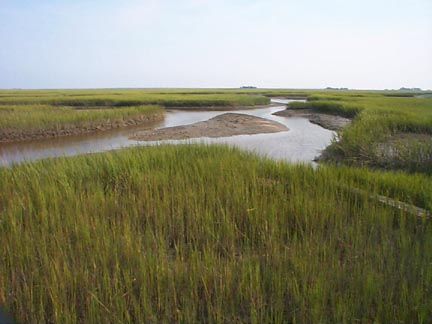 | The Flow of Energy: Primary Product to Higher Trophic Levels "All flesh is grass." Iii hundred trout are needed to support one man for a twelvemonth. The trout, in turn, must consume 90,000 frogs, that must consume 27 meg grasshoppers that live off of 1,000 tons of grass. |
In this lesson we will respond the question of why big tearing animals are rare, and along the manner nosotros will learn to respond the post-obit questions as well:
- How much of the sun'due south free energy is available to and alloyed by plants, and how is that measured?
- How are gross production, net product, and ecosystem production related?
- How are standing crop, turnover charge per unit, and internet primary production related?
- What types of ecosystems have the highest rates of production, and which brand the biggest contributions to worldwide master product?
- What factors limit the amount of primary production locally and worldwide?
- What is the efficiency with which free energy is converted from trophic level to trophic level?
- What are the differences between assimilation efficiency, net production efficiency, and ecological efficiency?
- How do ecosystems differ in the amount of biomass or number of organisms nowadays at whatever point in time, and generated over time, at each trophic level?
- How much free energy is bachelor to humans, how much practise we utilize, and is that corporeality sustainable?
Jump to: [Introduction] [Production] [Energy Transfer] [Fox and Hare Example] [Pyramids Models] [Human being Energy Consumption] [Summary]
Introduction - Energy Flows in Food Webs
Nosotros all know that the biggest, fiercest, predators such as tigers and Great White sharks are rare on Earth compared to other organisms. Exercise y'all know why? In the early days of discovery in the new field of "animal environmental", a scientist named Charles Elton took the mutual knowledge that "big fish consume piddling fish" and turned that into an organizing principle we withal use today -- that principle says that plants and animals are organized into trophic or "feeding" chains and food webs of interaction. He as well introduced the thought that at that place is a pyramid of numbers of organisms, where in that location are for case many plants at the base of the food web, fewer herbivores that graze on those plants, and fewer yet predators that eat the herbivores. Thus, Elton knew from observing the world effectually him that big, fierce creatures were rare, but, he didn't know why. He didn't sympathize the "machinery" or explanation for the rarity of top predators in food webs. In this lecture we will uncover that mechanism and respond that question, and we volition do so by learning nearly the nature of the catamenia of free energy in ecosystems. Energy is used upwards and lost as heat every bit it moves through ecosystems, and new energy is continually added to the Earth in the form of solar radiation. Every bit we learned in the lecture about Ecosystems, the Earth is an open organization in regard to energy, and information technology is a closed organisation in regard to the materials such as nutrients that are continually recirculated within and amoung ecosystems.Both energy and materials are essential to ecosystem construction, function, and limerick. Y'all have already been exposed to the basic concepts of nutrient cycles; in this lecture we focus on energy. Annotation that in terms of the cycling of carbon, "materials" and energy tin can be inter-converted. For case, nosotros know how many calories (a mensurate of energy) a gram of certain carbon compounds such every bit fats or carbohydrates incorporate.
Autotrophs verses Heterotrophs
As a brief review, we recognize that some organisms are capable of synthesizing organic molecules from inorganic precursors, and of storing biochemical energy in the process. These are called autotrophs, significant "self-feeding." Autotrophs likewise are referred to as primary producers. Organisms able to manufacture circuitous organic molecules from elementary inorganic compounds (h2o, CO2, nutrients) include plants, some protists, and some bacteria. The process past which they do this usually is photosynthesis, and equally its name implies, photosynthesis requires light (see Effigy ane).
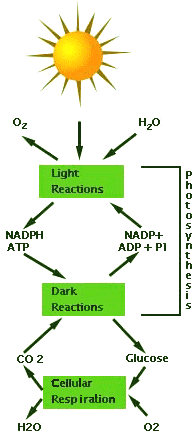 For completeness, we should mention the pathway known as chemosynthesis. Some producer organisms, by and large specialized bacteria, tin can convert inorganic nutrients to organic compounds without the presence of sunlight. There are several groups of chemosynthetic leaner in marine and freshwater environments, particularly those rich in sulfur or hydrogen sulfide gas. Similar chlorophyll-bearing plants and other organisms capable of photosynthesis, chemosynthetic organisms are autotrophs (see microbes lecture notes for more data). Many organisms can merely obtain their energy by feeding on other organisms. These are chosen heterotrophs. They include consumers of whatsoever organism, in whatsoever form: plants, animals, microbes, even dead tissue. Heterotrophs as well are called consumers.
For completeness, we should mention the pathway known as chemosynthesis. Some producer organisms, by and large specialized bacteria, tin can convert inorganic nutrients to organic compounds without the presence of sunlight. There are several groups of chemosynthetic leaner in marine and freshwater environments, particularly those rich in sulfur or hydrogen sulfide gas. Similar chlorophyll-bearing plants and other organisms capable of photosynthesis, chemosynthetic organisms are autotrophs (see microbes lecture notes for more data). Many organisms can merely obtain their energy by feeding on other organisms. These are chosen heterotrophs. They include consumers of whatsoever organism, in whatsoever form: plants, animals, microbes, even dead tissue. Heterotrophs as well are called consumers.
In this lecture we will brainstorm with a consideration of principal production, and in the side by side lecture we will examine what happens to this energy as information technology is conveyed along a food concatenation.
The Process of Chief Product
The general term "Production" is the creation of new organic matter. When a crop of wheat grows, new organic affair is created by the process of photosynthesis, which converts calorie-free energy into free energy stored in chemical bonds inside plant tissue. This energy fuels the metabolic mechanism of the institute. New compounds and structures are synthesized, cells divide, and the found grows in size over fourth dimension. Equally was discussed in item in a previous lecture, the constitute requires sunlight, carbon dioxide, h2o, and nutrients, and through photosynthesis the establish produces reduced carbon compounds and oxygen.Whether one measures the rate at which photosynthesis occurs, or the charge per unit at which the individual plant increases in mass, ane is concerned with primary production (definition: the synthesis and storage of organic molecules during the growth and reproduction of photosynthetic organisms). The core idea is that new chemic compounds and new plant tissue are produced. Over time, primary production results in the addition of new plant biomass to the system. Consumers derive their free energy from primary producers, either straight (herbivores, some detritivores), or indirectly (predators, other detritivores).
Is there an Upper Limit to Primary Production? The short answer is "aye". Let's briefly consider how much energy is in fact captured by autotrophs, and examine how efficient is the process of photosynthesis. Recall that the intensity of solar radiation reaching the world'due south surface depends partly on location: the maximum energy intensity is received at the equator, and the intensity decreases equally we move toward the poles. As nosotros saw in the lecture on ecosystems, these differences have profound effects on climate, and lead to the observed geographic patterns of biomes.
Furthermore, we know that only a minor fraction of the sun'southward radiation is actually used in the photosynthetic reaction in plants at the Earth's surface. Of the total solar radiation striking the World's outer atmosphere, about one-half of it is reflected back to space by ice, snow, oceans, or deserts, or absorbed by gases in the atmosphere - for case, the temper's ozone gas layer absorbs nearly all ultraviolet light, which makes upward most 9% of the sun's radiations.
Overall, of the light that reaches Earth's surface, merely almost half of it is in the wavelength range that can exist used by plants in photosynthesis (~400-700 nm wavelength) - this is chosen the Photosynthetically Active Radiation, or PAR. Plants strongly absorb light of blueish and red wavelengths (hence their green color, the result of reflection of green wavelengths), too equally light in the far infrared region, and they reflect lite in the almost infrared region. Even if the wavelength is right, the lite free energy is not all converted into carbon past photosynthesis. Some of the light misses the leafage chloroplast, where the photsynthetic reactions occur, and much of the energy from light that is converted by photosynthesis to carbon compounds is used upward in keeping the constitute biochemical "mechanism" operating properly - this loss is generally termed "respiration", although it also includes thermodynamic losses. Plants exercise not, then, use all of the light free energy theoretically available to them (see Figure 2).
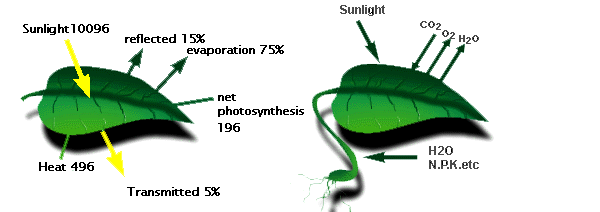
Figure 2 : Reduction of free energy available to plants
On average, plant gross main production on globe is most 5.83 x 106 cal m-two yr-ane. This is nigh 0.06% of the amount of solar energy falling per foursquare meter on the outer edge of the earth'southward atmosphere per year (defined as the solar abiding and equal to one.05 ten 10x cal grand-2 yr-1). After the costs of respiration, plant net main production is reduced to 4.95 x 10six cal yard-2 yr- 1, or almost 0.05% of the solar constant. Notation that this is the "average" efficiency, and in country plants this value tin attain ~2-iii% and in aquatic systems this value can reach ~1%. This relatively low efficiency of conversion of solar free energy into energy in carbon compounds sets the overall corporeality of free energy available to heterotrophs at all other trophic levels.
Some Definitions
And then far we have not been very precise about our definitions of "production", and nosotros need to brand the terms associated with product very clear.
* Gross Primary Production, GPP, is the total corporeality of CO2 that is fixed by the plant in photosynthesis.
* Respiration, R, is the amount of CO2 that is lost from an organism or arrangement from metabolic activity. Respiration can exist further divided into components that reflect the source of the CO2.
Rp =Respiration by Plants
Rh = Respiration past Heterotrophs
Rd = Respiration by Decomposers (the microbes)
* Net Master Production, NPP, is the net amount of primary product afterward the costs of establish respiration are included. Therefore, NPP = GPP - R
* Net Ecosystem Production, NEP, is the net amount of main production after the costs of respiration past plants, hetertrophs, and decomposers are all included. Therefore, NEP = GPP - (Rp + Rh + Rd)
A measure of Net Ecosystem Production is of bang-up interest when determining the CO2 balance between diverse ecosystems, or the entire Earth, and the atmosphere. This will be discussed more in our lectures on climatic change and the global carbon cycle.
Note that in these definitions nosotros are concerned only with "primary" and not "secondary" production. Secondary production is the gain in biomass or reproduction of heterotrophs and decomposers. The rates of secondary production, as we will see in a coming lecture, are very much lower than the rates of main production.
An everyday instance of how GPP, NPP, and R are related. To better understand the relationship betwixt respiration (R), and gross and net primary production (GPP and NPP), consider the following example. Let'south say that you take a part-time job and brand $100 per calendar week that goes straight into your depository financial institution business relationship. This is your "gross production" of coin, and it is coordinating to the gross production of carbon stock-still into sugars during photosynthesis. Now let'due south say that y'all spend $50 per calendar week from your bank business relationship on food, which in part is necessary for you to stay alive and in good health and able to keep going to your part-time job. That is the "cost" you pay to keep operating, and information technology is analogous to the respiration cost that a plant has when their cells use some of the energy fixed in photosynthesis to build new enzymes or chlorophyll to capture calorie-free or to get rid of waste product products in the cell. Thus in your bank business relationship your gross product is $100/week, your price of living (respiration) is $50 per week, and the "cyberspace" corporeality of money that y'all produce each week (your internet production) is $100 - $50 = $50. You tin come across that your depository financial institution account residue is determined every bit follows: Your Net product is equal to your Gross Product minus Respiration, which is the same as the equation above that states the Internet Main Production (NPP) = the Gross Primary Production (GPP) minus Respiration (R).
Measuring Chief Production
Yous may already have some thought of how one measures master production. There are two general approaches: i can measure out either (a) the rate of photosynthesis , or (b) the charge per unit of increase in plant biomass . Will they give the same answer?(a) Rate of Photosynthesis :
You know the equation for photosynthesis from a previous lecture:
6 CO2+ 6 HiiO à sunlight à Chalf-dozenH12Osix + half dozen O2
If we could place our plants in a closed arrangement, and measure the depletion of CO2 per unit fourth dimension, or the generation of O2, we would have a straight measure of principal production.
The method used in studies of aquatic master production illustrates this method well. In the surface waters of lakes and oceans, plants are mainly unicellular algae, and most consumers are microscopic crustaceans and protozoans. Both the producers and consumers are very small, and they are easily contained in a liter of h2o. If you put these organisms in a bottle and turn on the lights, you get photosynthesis. If you lot plow off the lights, you turn off the primary product.
However, darkness has no effect on respiration. Remember that cellular respiration is the reverse process from photosynthesis, as follows.
C6H12O2 à half dozen CO2 + 6 H2O
Photosynthesis stores free energy, and respiration releases it for use in functions such as reproduction and basic maintenance. When calculating the amount of energy that a plant stores as biomass, which is then available to heterotrophs, we must subtract plant respiration costs from the total primary production.
The general process is so unproblematic that master production of the world's oceans has been mapped in considerable detail, and many of the world'south freshwater lakes have likewise been investigated (Figure 3). Ane takes a series of small glass bottles with stoppers, and half of them are wrapped with some fabric such as tin foil and then that no calorie-free penetrates. These are called the "low-cal" and "dark" bottles, respectively.
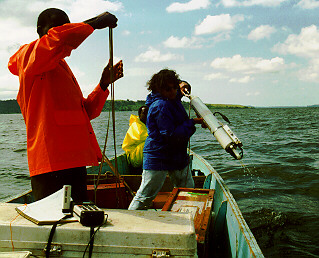
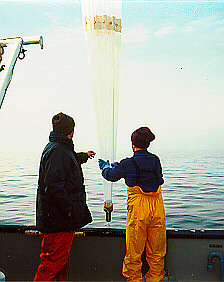
Effigy three. "Limnologists" (people who study lakes and streams) working
on Lake Victoria in East Africa (left) and on Lake Michigan (right).
The bottles are filled with h2o taken from a particular place and depth; this water contains the tiny plants and animals of the aquatic ecosystem. The bottles are closed with stoppers to foreclose any exchange of gases or organisms with the surrounding water, and so they are suspended for a few hours at the same depth from which the water was originally taken. Inside the bottles CO2 is being consumed, and O2 is beingness produced, and we can measure the alter over time in either one of these gases.
For example, the amount of oxygen dissolved in h2o can be measured easily by chemical titration. Earlier suspending the bottles, the initial O2 concentration is determined and expressed equally mg of O2 per Liter of h2o (mg/Fifty). And so, the final value is measured in both the low-cal and dark bottles subsequently a timed duration of incubation. What processes are taking place in each canteen that might alter the original Oii or CO2 concentrations? The equations below describe them.
Light bottle : In the lite bottle there is photosynthesis, or Gross Primary Product (GPP), and in that location is Respiration (R). The difference between these two processes, equally we saw above, is Internet Principal Production = NPP = (GPP - R)
Nighttime canteen: In the night bottle there is no photosynthesis and merely respiration. (In this example we may also have some consumer respiration in both bottles, unless we used a net to sieve out tiny heterotrophs.)
Now consider the following simple case. It illustrates how we business relationship for changes from the initial oxygen concentrations in the water that occurred during the incubation. We volition assume that our incubation period was ane hr. Measured oxygen concentrations:
Initial bottle = 8 mg Otwo /L ; Light canteen = 10 mg O2 /L ; Nighttime bottle = 5 mg O2 /50
The oxygen increased in the lite bottle compared to the initial due to photosynthesis, and the oxygen decreased in the nighttime bottle due to respiration. With this data we can calculate the Respiration, NPP, and GPP for our system:
(Light - Initial) = (10 - viii) = ii mg/L/60 minutes = (GPP - R) = NPP
(Initial - Dark) = (viii - 5) = 3 mg/L/hr = Respiration
(Low-cal - Nighttime) = (ten - 5) = 5 mg/Fifty/hr = (NPP + R) = GPP
Thus we take a measure of the net and gross principal production also as the respiration of our system. The oxygen technique is express in situations where the chief product is very low. In these situations, the radioactive form of carbon, C14 (14CO2), can be used to monitor carbon uptake and fixation. You can as well convert the results betwixt the oxygen and carbon methods past multiplying the oxygen values by 0.375 to put them into carbon equivalents (the factor comes from differences in atomic mass).
(b) Rate of Biomass Accumulation:
What practice y'all do with plants that are too large to put into bottles? Consider the following example. Suppose we wish to know the primary production of a corn crop. Nosotros constitute some seeds, and at the stop of one year we harvest samples of the entire plants including the roots that were contained in one square meter of expanse. Nosotros dry these to remove any variation in h2o content, and then weigh them to get the "dry weight". Thus our measure of primary production would be grams m-ii twelvemonth-ane of stems, leaves, roots, flowers and fruits, minus the mass of the seeds that may have blown abroad. What accept we measured?
It isn't GPP, because some of the free energy produced by photosynthesis went to meet the metabolic needs of the corn plants themselves. Is it NPP? Well, if we excluded all the consumers such equally insects of the corn plant, we would accept a measure of NPP. Simply nosotros assume that some insects and soil arthropods took a share of the plant biomass, and since we did not measure that share, we actually have measured something less than NPP. Note that this is exactly the aforementioned situation in the bottle method we described to a higher place if modest heterotrophs that grazed on algae were included in the bottle, in which instance the two methods would measure the same thing.
In contempo years it has too become possible to estimate GPP and R in large plants or entire forests using tracers and gas exchange techniques. These measurements now form the basis of our investigations into how master production affects the carbon dioxide content of our atmosphere.
Product, Continuing Crop, and Turnover
With either of these methods, the primary Production tin can exist expressed every bit the rate of formation of new material, per unit of earth'south surface, per unit of measurement of fourth dimension. The production is reported as calories/thouii/twelvemonth (energy) or grams/mii/yr (dry out organic matter).Standing crop , on the other hand, is a measure of the biomass of the organization at a single point in time, and is measured as calories or grams per thoutwo. The difference between product and standing crop is a crucial ane, and can be illustrated by the following question. Should a forester, interested in harvesting the greatest yield from a plot, be more interested in the forest's standing crop or its primary product? Well, the key chemical element to the answer is "Time". If the forester wants a short term investment (i.e., to cut the forest down and sell the copse for maximum, firsthand profit), so the higher the standing crop the better. If instead the forester wants to manage the forest over time (sell some trees while growing more each year), then the rate at which the forest produces new biomass is critical.
The ratio of the continuing crop to the product (Standing Crop / Product) is equal to the Turnover of the system. By dividing standing crop (units of g/m2) by product (units of one thousand/m2/twelvemonth), you can encounter that the turnover is in units of 1/(1/yr) = year in this case. Thus the stock or standing crop of any material divided by the rate of product gives you a measure of fourth dimension. Notice how similar (really, identical) this turnover fourth dimension is to the residence time that you learned most in before lectures. It is really important to consider this chemical element of "time" whenever you lot are thinking nearly almost whatsoever aspect of an organism or an ecosystem or a problem in sustainability. Learning well-nigh how much of something is happening and how fast information technology is changing is a critical attribute of agreement the system well plenty to make decisions; for example, the decision of the forester above may exist driven by economic concerns or by conservation concerns, but the "best" choice for either of those concerns still depends on an understanding of the product, standing crop, and turnover of the forest. This highlights the indicate fabricated in earlier lectures that to make decisions about sustainability you must understand these basic scientific concepts.
Patterns and Controls of Primary Product in the Globe'south Ecosystems
The world's ecosystems vary tremendously in productivity, as illustrated in the following figures. In terms of NPP per unit expanse, the most productive systems are estuaries, swamps and marshes, tropical pelting forests, and temperate pelting forests (see Figure four). 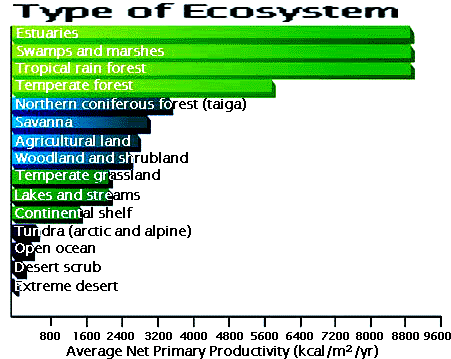
Effigy four. Net Principal Production per unit area of the world's common ecosystems.
If we wish to know the total corporeality of NPP in the earth, nosotros must multiply these values past the area that the various ecosystems occupy. In doing that, we detect that at present the about productive systems are open oceans, tropical rain forests, savannas, and tropical seasonal forests (encounter Figure v).
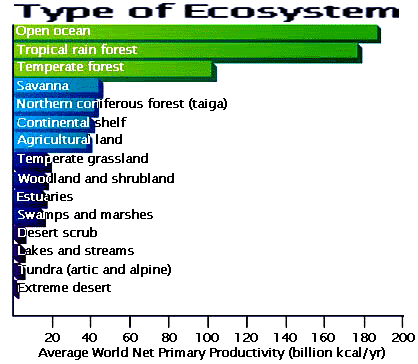
Figure 5. Average world net master production of various ecosystems.
What accounts for these differences in production per unit expanse? Basically, the answer is that climate and nutrients control primary productivity. Areas that are warm and moisture generally are more productive (meet Figures 6a and 6b). Overall, the amount of water available limits state main product on our world, in part due to the large areas of desert found on sure continents. Agricultural crops are particularly productive due to "artificial" subsidies of water and fertilizers, as well as the control of pests.
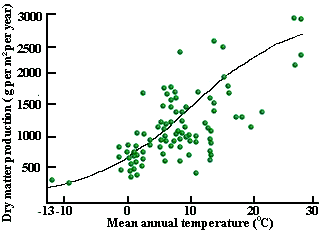
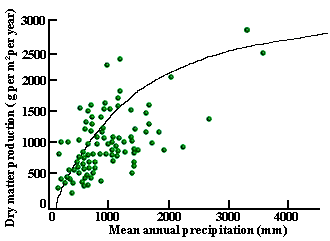
Figures 6a and 6b. Graphs showing the human relationship
betwixt NPP and precipitation, and between NPP and temperature.
Even though temperature and especially precipitation are related to production, y'all will notice a large degree of "besprinkle" around the line of best fit fatigued in the graphs above. For case, wait at the range of product values (Y axis) at a temperature value of 10 deg C or at a atmospheric precipitation value of 1000 mm. The scatter or variation in the product due in function to other aspects of item (local) systems, such as their nutrient availability or their turnover rates. For example, grasslands can accept a relatively high rate of chief production occurring during a brief growing flavour, even so the standing crop biomass is never very great. This is indicative of a high turnover charge per unit. In a forest, on the other hand, the continuing ingather biomass of higher up-ground wood and below-footing roots is large. Each yr'south production of new institute affair is a pocket-sized fraction of total standing crop, and then the turnover of forest biomass is much lower.
Another practiced example is seen in the oceans, where nearly of the primary production is concentrated in microscopic algae. Algae accept short life cycles, multiply quickly, do non generate much biomass relative to their numbers, and are eaten rapidly past herbivores. At whatsoever given point in time, then, the standing crop of algae in an bounding main is likely low, merely the turnover rate can be high (see below) Nosotros take now examined the first step in the flow of energy through ecosystems: the conversion of energy by primary producers into a form that is usable past heterotrophs, as well as by producers themselves. In the next lecture we volition examine how this energy moves through the balance of the ecosystem, providing fuel for life at higher trophic levels.
Summary of Part 1, Main Product
-
Organisms are characterized as autotrophs and heterotrophs. Autotrophs produce their own food by fixing energy through photosynthesis or, less commonly, chemosynthesis. Heterotrophs must feed on other organisms to obtain energy.
-
Primary production is the creation of new organic matter past plants and other autotrophs. It can be described per unit area for individual ecosystems or worldwide. Production as well is a rate, measured per time unit, while standing ingather biomass is the corporeality of plant matter at a given indicate in time. The ratio of standing ingather to production is chosen turnover. The turnover fourth dimension of a system is important in determining how a system functions.
-
Production rates can be quantified by a simple method by which oxygen or carbon production is measured. Product can also be quantified by measuring the rate of new biomass aggregating over time. The stardom between gross primary production (GPP), net primary production (NPP), and net ecosystem production (NEP) is critical for understanding the energy balance in plants and in whole ecosystems.
-
Production varies among ecosystems, as well every bit over time within ecosystems. Rates of production are adamant by such factors as climate and nutrient supply. Precipitation is the dominant command worldwide, merely nutrient availability often limits principal production in any item, local system.
The Flow of Energy to Higher Trophic Levels
In the section above nosotros examined the cosmos of organic matter by primary producers. Without autotrophs, there would be no energy available to all other organisms that lack the capability of fixing light energy. Nonetheless, the continual loss of energy due to metabolic activity puts limits on how much free energy is available to higher trophic levels (this is explained by the Second Constabulary of Thermodynamics). Today we will look at how and where this energy moves through an ecosystem once it is incorporated into organic thing.Near of you lot are now familiar with the concept of the trophic level (encounter Effigy one). Information technology is simply a feeding level, every bit oftentimes represented in a nutrient chain or food spider web. Primary producers comprise the bottom trophic level, followed past master consumers (herbivores), and then secondary consumers (carnivores feeding on herbivores), and so on. When we talk of moving "up" the nutrient chain, we are speaking figuratively and mean that we motion from plants to herbivores to carnivores. This does not take into account decomposers and detritivores (organisms that feed on dead organic matter), which make up their own, highly of import trophic pathways.
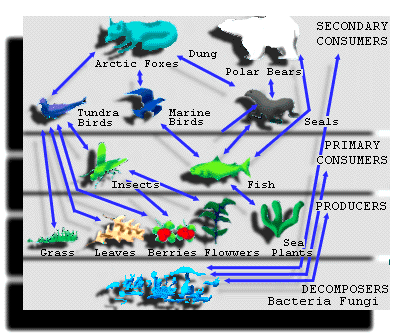
Figure one: Trophic levels.
In the procedure, metabolic work is done and energy in chemical bonds is converted to oestrus free energy. If NPP was not consumed, it would pile up somewhere. Unremarkably this doesn't happen, but during periods of Earth's history such every bit the Carboniferous and Pennsylvanian, enormous amounts of NPP in excess of the deposition of organic matter accumulated in swamps. Information technology was buried and compressed to form the coal and oil deposits that we mine today. When we burn these deposits (same chemical reaction every bit higher up except that at that place is greater energy produced) we release the free energy to drive the machines of industry, and of course the CO2 goes into the temper every bit a greenhouse gas. This is the situation that we accept today, where the excess COii from called-for these deposits (past excess NPP) is going into the atmosphere and building up over time, dramatically changing our climate.
But let'south get back to an ecosystem that is balanced, or in "steady land" ("equilibrium") where almanac total respiration balances annual full GPP. As energy passes from trophic level to trophic level, the following rules apply:
- Only a fraction of the free energy available at one trophic level is transferred to the next trophic level. The rule of pollex is x%, simply this is very guess.
- Typically the numbers and biomass of organisms subtract every bit one ascends the nutrient concatenation.
An Instance: The Fox and the Hare
To sympathise these rules, we must examine what happens to energy within a food chain. Suppose we have some amount of plant matter consumed by hares, and the hares are in turn consumed by foxes. The following diagram (Effigy 2) illustrates how this works in terms of the free energy losses at each level.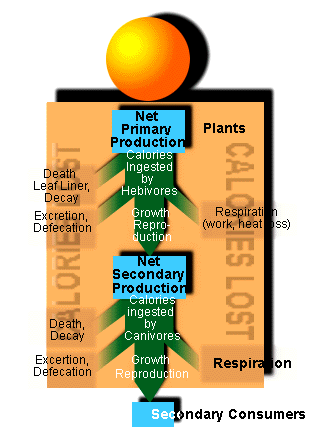
A hare (or a population of hares) ingests plant thing; we'll telephone call this ingestion. Part of this material is processed by the digestive system and used to make new cells or tissues, and this part is called absorption. What cannot exist assimilated, for example possibly some parts of the plant stems or roots, exits the hare's trunk and this is called excretion. Thus nosotros tin can brand the following definition: Assimilation = (Ingestion - Excretion). The efficiency of this procedure of assimilation varies in animals, ranging from 15-50% if the food is plant material, and from 60-90% if the food is creature material.
The hare uses a meaning fraction of the alloyed free energy just being a hare -- maintaining a loftier, constant trunk temperature, synthesizing proteins, and hopping about. This energy used (lost) is attributed to cellular respiration. The remainder goes into making more hare biomass by growth and reproduction (that is, increasing the overall biomass of hares by creating offspring). The conversion of assimilated free energy into new tissue is termed secondary product in consumers, and it is conceptually the same equally the primary product or NPP of plants. In our example, the secondary production of the hare is the free energy bachelor to foxes who eat the hares for their needs. Clearly, because of all of the energy costs of hares engaged in normal metabolic activities, the energy available to foxes is much less than the energy available to hares.
But as we calculated the assimilation efficiency above, we tin can also calculate the net production efficiency for any organism. This efficiency is equal to the production divided by the assimilation for animals, or the NPP divided by the GPP for plants. The "product" here refers to growth plus reproduction. In equation form, we accept net production efficiency = (production / assimilation), or for plants = (NPP / GPP). These ratios measure out the efficiency with which an organism converts assimilated energy into principal or secondary production.
These efficiencies vary among organisms, largely due to widely differing metabolic requirements. For instance, on average warm-blooded vertebrates such as mammals and birds apply about 98% of alloyed energy for metabolism, leaving but ii% for growth and reproduction. On boilerplate, invertebrates utilise only ~fourscore% of assimilated energy for metabolism, and thus exhibit greater cyberspace production efficiency (~xx%) than do vertebrates. Plants have the greatest internet production efficiencies, which range from 30-85%. The reason that some organisms take such low internet production efficiencies is that they are homeotherms, or animals that maintain a constant internal body temperature (mammals and birds). This requires much more energy than is used by poikilotherms, which are also known as "common cold-blooded" organisms (all invertebrates, some vertebrates, and all plants, fifty-fifty though plants don't have "blood") that practise not regulate their temperatures internally.
Simply as we tin build our understanding of a system from the private to the population to the community, we can at present examine whole trophic levels by calculating ecological efficiencies. Ecological efficiency is defined as the free energy supply bachelor to trophic level North + 1, divided by the free energy consumed by trophic level Northward. You might remember of it equally the efficiency of hares at converting plants into trick food. In equation form for our example, the ecological efficiency = (play tricks production / hare production). Note that the ecological efficiency is a "combined" measure that takes into account both the assimilation and cyberspace production efficiencies. Yous can also combine different species of plants and animals into a single trophic level, and so examine the ecological efficiency of for instance all of the plants in a field being fed on my all of the unlike grazers from insects to cows.
Thinking about the overall ecological efficiency in a organization brings the states back to our get-go dominion for the transfer of energy through trophic levels and up the food chain. In general, only nigh 10% of the energy consumed by one level is available to the side by side. For example, If hares consumed m kcal of plant energy, they might simply be able to class 100 kcal of new hare tissue. For the hare population to be in steady state (neither increasing nor decreasing), each year's consumption of hares by foxes should roughly equal each twelvemonth's production of new hare biomass. So the foxes consume about 100 kcal of hare biomass, and convert perhaps x kcal into new fox biomass. In fact, this ecological efficiency is quite variable, with homeotherms averaging 1- v% and poikilotherms averaging 5-15%. The overall loss of energy from lower to higher trophic levels is important in setting the absolute number of trophic levels that any ecosystem can incorporate.
From this understanding, it should be obvious that the mass of foxes should be less than the mass of hares, and the mass of hares less than the mass of plants. More often than not this is true, and we can correspond this concept visually by constructing a pyramid of biomass for whatever ecosystem (see Figure 3).
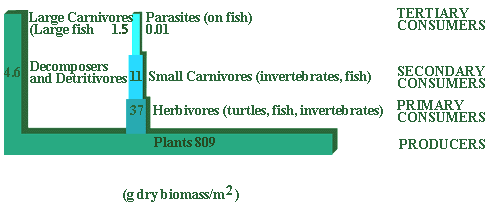
Figure iii. A pyramid of biomass showing producers and consumers in a marine ecosystem.
Pyramids of Biomass, Energy, and Numbers
A pyramid of biomass is a representation of the amount of energy contained in biomass, at different trophic levels for a given bespeak in time (Effigy three, above, Effigy 4-heart below). The amount of energy available to one trophic level is limited past the amount stored by the level beneath. Considering free energy is lost in the transfer from ane level to the next, there is successively less total energy as y'all move up trophic levels. In general, we would wait that higher trophic levels would have less total biomass than those below, because less energy is available to them.We could besides construct a pyramid of numbers, which every bit its name implies represents the number of organisms in each trophic level (encounter Figure 4-superlative). For the grassland shown in Figure 4-summit, the lesser level would be quite large, due to the enormous number of small plants (grasses). For other ecosystems such every bit the temperate wood, the pyramid of numbers might be inverted: for instance, if a forest'due south found community was composed of only a handful of very big trees, and yet in that location were many millions of insect grazers which ate the plant material.
Just as with the inverted pyramid of numbers, in some rare exceptions, there could be an inverted pyramid of biomass, where the biomass of the lower trophic level is less than the biomass of the next higher trophic level. The oceans are such an exception because at whatever point in time the total amount of biomass in microscopic algae is pocket-size. Thus a pyramid of biomass for the oceans tin announced inverted (meet Effigy 4b-middle). Y'all should at present ask "how can that exist?" If the amount of free energy in biomass at ane level sets the limit of free energy in biomass at the next level, as was the example with the hares and foxes, how tin you accept less energy at the lower trophic level? This is a proficient question, and tin exist answered past considering, as we discussed above, the all important aspect of "time". Even though the biomass may be small, the RATE at which new biomass is produced may be very big. Thus over time it is the amount of new biomass that is produced, from whatsoever the continuing stock of biomass might be, that is important for the next trophic level.
Nosotros can examine this further by constructing a pyramid of energy, which shows rates of product rather than standing crop. Once done, the figure for the ocean would have the characteristic pyramid shape (encounter Effigy 4-bottom). Algal populations tin can double in a few days, whereas the zooplankton that feed on them reproduce more slowly and might double in numbers in a few months, and the fish feeding on zooplankton might just reproduce once a yr. Thus, a pyramid of free energy takes into account the turnover rate of the organisms, and tin never be inverted . Note that this dependence of ane trophic level on a lower trophic level for energy is why, every bit you learned in the lectures on predation, the prey and predator population numbers are linked and why they vary together through fourth dimension (with an start).
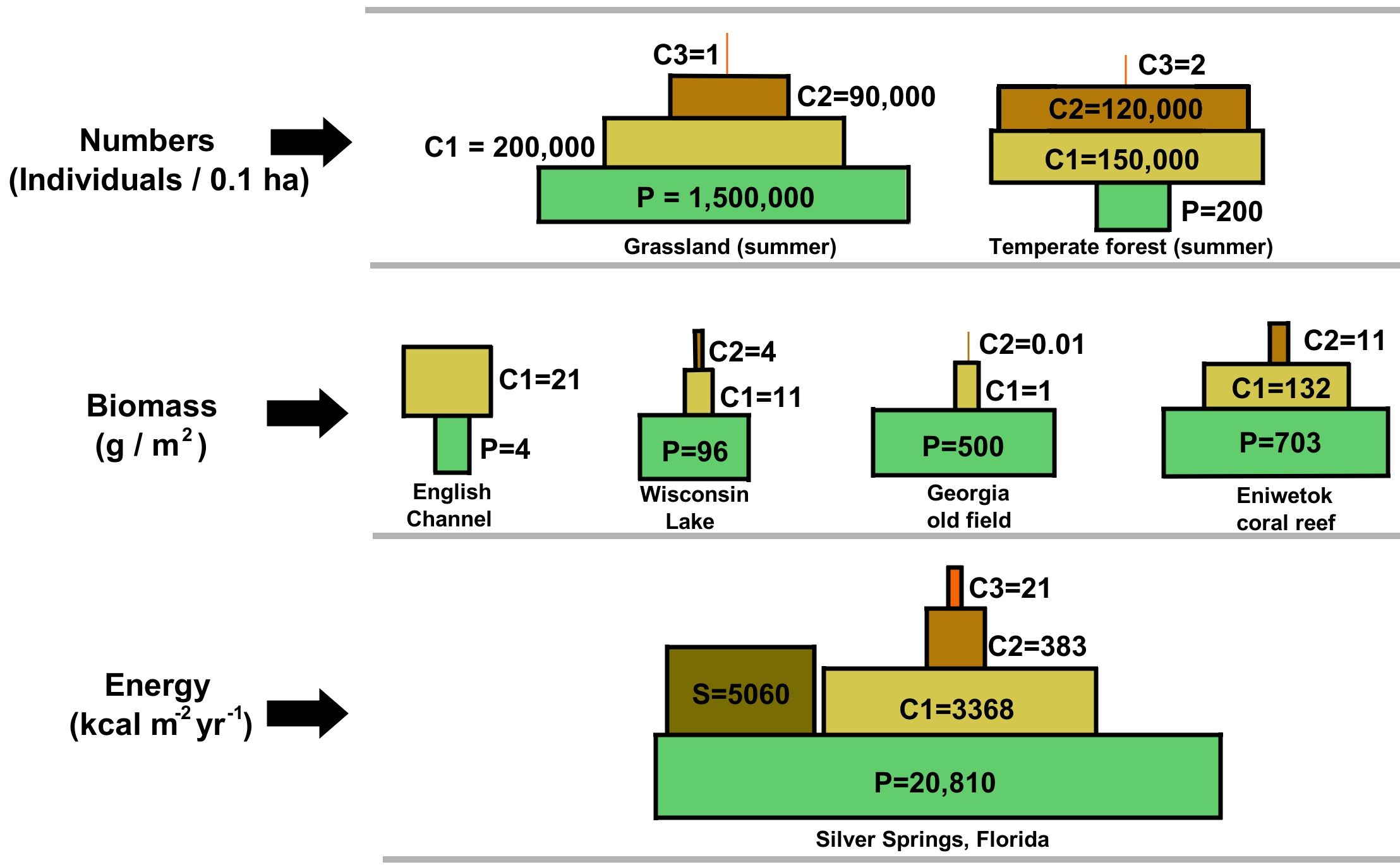
Figure 4: Pyramids of numbers, biomass, and energy for various ecosystems.
The Residence Time of Free energy. Nosotros meet that thinking about pyramids of energy and turnover time is similar to our discussions of residence time of elements. Only here nosotros are talking about the residence time of "energy". The residence time of energy is equal to the free energy in biomass divided by the net productivity, Rt = (free energy in biomass / net productivity). If nosotros calculate the residence time of energy in the primary producers of various ecosystems, we discover that the residence times range from about 20-25 years for forests (both tropical rainforests and boreal forests), down to ~3-5 years for grasslands, and finally down to only ten-15 days for lakes and oceans. This departure in residence time between aquatic and terrestrial ecosystems is reflected in the pyramids of biomass, as discussed above, and is as well very important to consider in analyzing how these different ecosystems would respond to a disturbance, or what scheme might all-time be used to manage the resource of the ecosystem, or how you might best restore an ecosystem that has been degraded (east.g., by storms or by humans).
Humans and Energy Consumption
All of the creature species on Earth are consumers, and they depend upon producer organisms for their food. For all practical purposes, it is the products of terrestrial plant productivity (and some marine found productivity) that sustain humans. What fraction of the terrestrial NPP practise humans use, or, "appropriate"? It turns out to exist a surprisingly large fraction, which launches us immediately into the question of whether this cribbing of NPP by humans is sustainable. Allow'due south use our knowledge of ecological energetics to examine this very important issue. (Why NPP? Because but the free energy "left over" from plant metabolic needs is available to attend the consumers and decomposers on Globe.) We tin start past looking at the Inputs and Outputs:Inputs: NPP, calculated every bit annual harvest. In a cropland NPP and annual harvest occur in the same year. In forests, annual harvest can exceed annual NPP (for instance, when a wood is cut down the harvest is of many years of growth), just we can still compute almanac averages.Note that the following estimates are being successively revised in the literature, merely the approach to the problem is always the same.
Outputs: 2 Scenarios
- Total productivity of lands devoted entirely to human activities. This includes total cropland NPP, and also energy consumed in setting fires to clear country.
- A loftier estimate is obtained by including lost productive capacity resulting from converting open land to cities, forests to pastures, and due to desertification and other overuse of land. This is an estimate of the total human impact on terrestrial productivity.
Units: Nosotros will use the Pg or Pedagram of organic matter (= xfifteen g, = 109 metric tons, = one "gigaton") (1 metric ton = 1,000 kg).
Table 1 provides estimates of full NPP of the world. There is some possibility that below-footing NPP is under-estimated, and as well marine NPP may be underestimated because the contribution of the smallest plankton cells is not well known. Total = 224.5 Pg
Table 1: Surface area by type of cover and total
(from Atjay et al. 1979 and De Vooys 1979).
| | (x 10half dozen km2) | (Pg) |
| Forest | 31 | 48.7 |
| Woodland, grassland, and savanna | 37 | 52.1 |
| Deserts | thirty | 3.ane |
| Arctic-alpine | 25 | 2.1 |
| Cultivated state | xvi | 15.0 |
| Human being area | 2 | 0.4 |
| Other terrestrial | vi | 10.7 |
| Subtotal terrestrial | 147 | 132.1 |
| Lakes and streams | ii | 0.8 |
| Marine | 361 | 91.6 |
| Subtotal aquatic | 363 | 93.4 |
| Total | 510 | 224.5 |
ane. The Low Calculation: (Come across Table ii)
(a) Plant textile directly consumed = ~5 billion people X 2500 kcal/person/day Ten 0.2 (to convert kcal to organic thing) = 0.91 Pg of organic matter. If we presume that 17% of these calories derive from animate being products, humans directly consume 0.76 Pg of plant matter. Approximate of human harvest of grains and other found crops is 1.xv Pg annually. This implies loss, spoilage, or wastage of 0.39 Pg, or 34% of the total harvest.(b) Consumption by livestock: estimates range from 2.viii to 5 Pg, and there seems to be some uncertainty here. Our low estimate uses 2.2 Pg.
(c) Forests: harvest of wood for construction and fiber is well known. Amount used for firewood, especially in tropics, is not. The table gives a low estimate.
(d) Fish harvest: 0.075 Pg wet weight = 0.02 Pg dry out wt. If we assume the average fish is two trophic transfers (@ 10% each) to a higher place primary producers, the NPP to produce those fish was 2 Pg annually.
(e) Nosotros add to the depression calculation the amount of NPP co-opted by humans:
(i) All cropland NPP
(2) All pastureland that was converted from other ecosystem types, NPP consumed past livestock on natural grazing land, and human-set fires
(three) A number of forest land uses
(4) Human occupied areas including lawns, parks, golf courses, etc.
The total is 42.6 Pg of NPP per year, or nineteen% of earth NPP.
| | (Pg) |
| Cultivated country | 15.0 |
| Grazing state: Converted pastures Consumed on natural grazing lands Burned on natural grazing country Subtotal | 9.8 0.viii 1.0 11.6 |
| Forest land: Killed during harvest, not used Shifting cultivation Land clearing Forest plantation productivity Forest harvests Subtotal | 1.3 half-dozen.ane ii.4 1.6 2.2 thirteen.vi |
| Human-occupied areas | 0.4 |
| SUBTOTAL TERRESTRIAL | xl.6 |
| Aquatic ecosystems | 2.0 |
| TOTAL | 42.6 |
| Pct terrestrial co-opted (40.6/132.1) | 30.vii % |
| Pct aquatic co-opted (2.0/92.iv) | two.2 % |
two. The High Adding: (Run across Tabular array three)
For the high guess we now include both co-opted NPP and potential NPP lost as a consequence of human activities:
(a) Croplands are likely to be less productive than the natural systems they supercede. If we use production estimates from savanna-grasslands, it looks similar cropland production is less by 9 Pg.(b) Forest conversion to pasture: the roughly 7 one thousand thousand km2 of forest converted to pasture represents a loss of one.four Pg.
(c) Overuse: Some 35 million km2 of land has been made more arid and less productive as a upshot of homo overuse, some 15 one thousand thousand km2 severely so. Using dry savanna estimates of NPP, global NPP has been reduced by iv.5 Pg.
(d) Country conversion: Assuming the 2 million km2 of land in cities, highways, etc. had a productivity equivalent to natural forests, two.half-dozen Pg of NPP is foregone.
The total for the high estimate is 58.1 Pg of NPP used, co-opted, or lost. We also must add the potential NPP to the earth estimated NPP before we compute the fraction appropriated past humans. This gives us 58.1/149.6, or nearly 40% of potential terrestrial production (about 25 % of terrestrial + aquatic production). Caveat: These estimates are based on best available data and are estimate. They probably requite the correct gild of magnitude.
Additions to Table 3 from processes that co-opt or degrade NPP.
| | (Pg) |
| Previous terrestrial total (Table iii) | 40.6 |
| Decreased NPP in agriculture | nine |
| Conversion of wood to pasture | 1.four |
| Desertification | iv.5 |
| Loss to homo areas | 2.half dozen |
| Full terrestrial | 58.i |
| Percent terrestrial co-opted or lost (58.1/149.8) | 38.8% |
| Percent terrestrial plus aquatic co-opted or lost [lx.1/(149.8+92.4)] | 24.8% |
Inferences:
What can nosotros conclude from the higher up analysis of the fate of net master production in our world?
(a) Homo use of marine productivity is relatively pocket-size. Moreover, although major fish stocks are heavily fished, and many littoral areas are severely polluted, human affect on the seas is less than on state. Even so, we do know that except for some aquaculture systems, any marine or freshwater fishery that humans accept used we have over-exploited, and oftentimes nosotros take ruined the fishery.
(b) On land, one species, Human being sapiens, commands most 40% of the full terrestrial NPP. This has probably never occurred before in Earth's history.
(c) At that place are many consequences of this co-choice of NPP by humans. The consequences include environmental degradation, species extinctions, and altered climate.
Is our use of primary productivity sustainable?
The Human "conveying capacity" on Globe is hard to approximate, because information technology depends upon abundance of a population and the technology supporting that population (recall back to your Ecological Footprint calculations in lab). But at present levels of affluence and engineering science, a population fifty to 100% larger than we have today would push our use of terrestrial NPP to well over 50% of the available product, and the attention degradation of ecosystems such as air and h2o pollution would exist of major business organization. Some people believe that "technology will salvage us", and that agricultural systems will become more efficient and that new genetics of plants volition make production more efficient. Unfortunately, and as nosotros have seen in this and other lectures, at that place are true limits to principal product based on the amount of light energy bachelor at Globe's surface, and the efficiency at which light energy can be converted into carbon during photosynthetic reactions. Thus the limits to unchecked growth must be very well-nigh. Notice that the lower we every bit humans "feed" on the trophic chain, the more efficient the spider web of life becomes -- eating animals that eat animals that eat plants is a very inefficient apply of solar energy.
One final point to consider is that human systems need to be unproblematic, and are limited by our understanding of "complication" and of how to build complex systems. Simple systems, with low diversity of pieces and few moving parts, piece of work best (retrieve cars, bridges, wellness-intendance plans). This contrasts with ecosystems, where nature has solved this trouble and evolved incredibly diverse, circuitous systems (think tropical pelting forests and coral reefs with millions of species). These systems operate with efficiency and stability over time. In other words, they are inherently "sustainable". One reason for this difference, or at to the lowest degree a starting indicate for discussion, is that natural systems are always express past the food available for organisms. However, humans systems overall (or on average) are not withal limited past the food energy available. As this state of affairs changes in the time to come with population growth and more than demands on master productivity, we know from our understaning of energy flow in natural systems that "Ecological Efficiency will become the states in the end" - and that is the last take-dwelling point for this lecture.
Summary of Role 2, Higher Trophic Levels
-
Only a fraction of the free energy available at one trophic level is transferred to the adjacent trophic level; the fractions can vary between 1-fifteen%, with an average value of 10%.
-
Typically the numbers and biomass of organisms decreases equally ane ascends the food concatenation.
-
We tin can construct pyramids of biomass, energy, and numbers to represent the relative sizes of trophic levels in ecosystems. Pyramids can oftentimes exist "inverted" equally a consequence of high product rates at lower trophic levels.
-
The human diet is derived from plant material. Humans may consume, co-opt or make unavailable equally much equally 40% of the earth's total terrestrial NPP for food, state, and other uses.
Primer on Photosynthesis
Review
-
Review of main terms and concepts in this lecture.
Suggested Readings
-
Wessells, N.K. and J.50. Hopson. 1988. Biology. New York: Random House, ch. 44
-
Townsend, C.R., J.L. Harper, and G. Begon. 2000. Essentials of Ecology. Blackwell Science.
- Hall, D.O and K. Yard. Rao. 1994. Photosynthesis. 5th Edition, Cambridge.
All materials � the Regents of the Academy of Michigan unless noted otherwise.

Source: https://www.globalchange.umich.edu/globalchange1/current/lectures/kling/energyflow/energyflow.html
0 Response to "what problems would you expect to observe in an ecosystem without primary consumers?"
Post a Comment